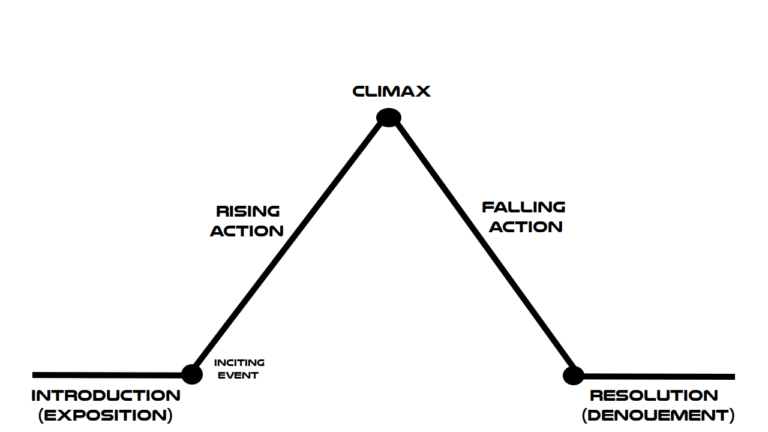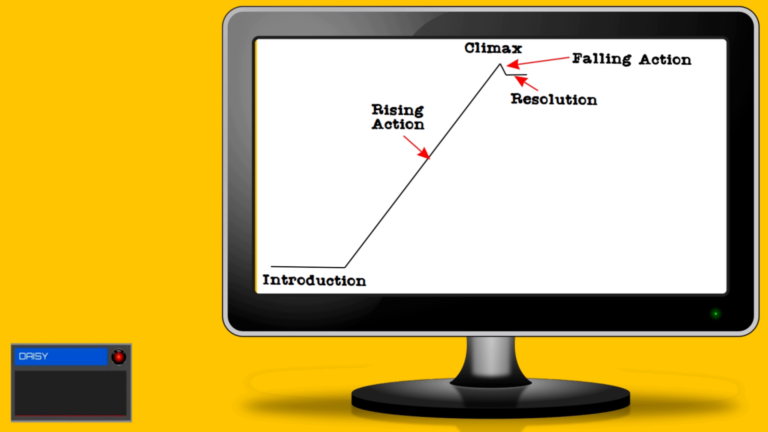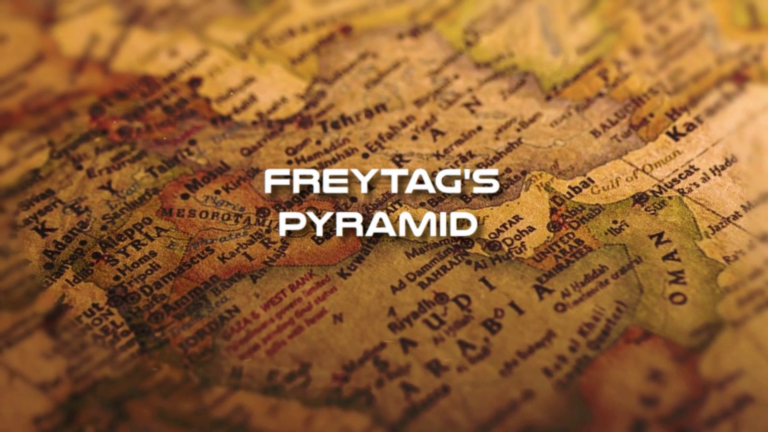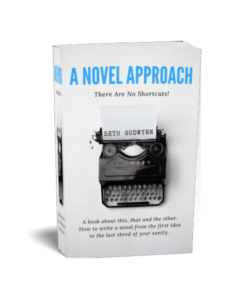Freytag's Pyramid
The Legendary Guide to Plotting and Scheming
A.P. Atkinson and The Other Guy
The plot is the backbone of your story; it’s the tale you’re telling. If you get it wrong, you’re cheating your reader and selling them a hollow, empty illusion. The ending should feel like a reward, like a final moment of respect to the reader. Getting to the end of a well–structured novel should be slightly disappointing, since you never want it to end, but it should deliver on all the hopes that you have built up along the way. Understanding what the needs of your story are ensures you’ve got the right characters in order to tell it. Getting the plot straight in your head makes everything else make sense. It’s the biggest, most important part of your story and if you get it wrong, nothing else will work.
The plot is your storyline; it’s the journey your characters undertake along the way to the finale. Freytag’s Pyramid is a visual representation of the outline of a plot, and it holds essentially true for all stories.
It begins with ‘exposition’ or ‘introduction.’ At this stage, we’re showing the reader the world; we’re leading them into the narrative and inviting them to meet the characters. We’re explaining who, what and where everything is happening. All stories do that, they lead us in and show us the town, country or setting of the tale. They usually introduce the protagonist first, but not always, and they give some ideas of who they are and what challenges they’re going to face. It lets us feel like we are familiar with the situation so that when things start to happen, we care about the outcome.
Next is ‘rising action.’ Rising action leads to the top of the pyramid. At the top, we find the climax. The climax is the bit where the story makes sense, or as it’s often described, the moment of highest tension. It’s the moment where all the threads of your plot come together. We reveal the point, our character triumphs, or the truth is revealed. It’s the biggest, boldest stroke and the thing that everything else has always led us to. When we reach the climax, I want my reader to smile; I want them to rub their chin and shake their head. I want them to realise that, of course that was happening. I want a surprise for them to discover, not a cheat, or something horribly out of character but a reveal of something that was only suggested before. I want them to see that the machinery, the cogs and wheel of the engine of my plot were turning towards creating this. It’s like stepping back from a painting and finally seeing the whole thing.
Rising action is everything that has led us there. From the introduction to the climax there must be challenges for our protagonist. They must overcome obstacles, they must find out what kind of a person they really are. A good tale takes the character on a journey, and the reader right along with them.
Plots should pitch the character against difficulties. Usually they will face adversaries who might oppose them but sometimes they might face a dire situation. As an example, they might be marooned on a desert island and have only to survive, but the odds stacked against them provide all the drama we need to stay invested.
Mostly we might have some kind of villain, someone who provides opposition to the main character. They might work against one another until the climax when the situation finally comes to a head and the whole thing clashes together.
Falling action leads us to the resolution. Freytag calls it the ‘catastrophe’ and warns that the main character should not be spared, but more often this is adjusted to a denouement, or resolution. The resolution is where we leave the situation. It’s the close of our story and it’s where we finally walk away from our characters. If you’ve done your job, it’s the end of that story but not the lives of the people in it. In the mind of the reader they know what happens next, they have ideas about who goes on to do what, what might become of them and where the story of their future lives might ultimately lead. The reader should have closure, unless, that is, you’re planning a sequel.
Fairy stories traditionally end with the words, ‘and they all lived happily ever after.’ You don’t need to nail your story down that hard, of course. You need to leave the reader wanting a little more, and making up their own mind about what happens to your characters next. Your resolution is you wrapping things up. It’s sweeping up after the party, just as the sun rises on a new day. The plot might be over now but you still can’t short–change the readers. You should strongly hint at how things have ended, especially for your main characters. Have new friendships been formed, have situations been overcome? How has that impacted their lives, where do they find themselves now and what does their future hold?
This is the part of your story that contains the last line, and it’s every bit as important as the first. Falling action is everything that gets us from the climax, back down to the last page of your book. When we see the pyramid the two lines appear equal but, in reality, they aren’t. The characters go on a grand journey through the rising action and they tumble quickly down to the end. The falling action is everything that happens between the climax and conclusion and there shouldn’t be too much of it. You’ve made your point, you’ve led your reader to the big finale and then you take them to the last moment as directly as possible. But there’s a lot more to writing plots than just that.




Exert from ‘A Novel Approach’, Free on our site.
So Fretag’s Pyramid lays out the markers in a plot and works very effectively as a tool to help you sort out how your story fits together, as you plan it out. But, what would that look like if we created a story completely around the framework that the diagram gives us? Would it make any sense? Would it be a readable story? Read on to find out...
Freytag's Pyramid
This was the only chance he was ever going to get. There was nowhere left to run, and he knew that they had him surrounded. Worse, they were beginning to close in.
William peered around, his chest heaving heavily as he fought to control the waves of fear that threatened to engulf him.
The Egyptian soldiers were everywhere, guns in their hands, and they had made it clear that they were not afraid to use them. The vault was dark and gloomy, even with the artificial light from electric flood lamps that were dotted around the cavern, connected to the outside world with bunches of long, snaking wires. The air inside was damp, despite the heat from the mid-afternoon sun beating onto the ground high up above the cave they were now in.
He knew he had no choice now, so he made a dash for the pyramid. His heart pounded as he ran the short distance and he gasped as he finally made it to the base. He got there just as the first shots rung out. The sound of gunfire echoed around the place. He dug his hand into a crack between gigantic carved rocks and he began to climb.
He had discovered it several years prior, almost by accident, and it had taken him this long to get into the secret chamber. But he had found it, this great hidden structure. He had found a previously undiscovered pyramid in an underground cave, of all places. It was a pyramid made from dusty yellow sandstone and granite, unseen by human eyes for countless centuries.
“Doctor Freytag!” Sergeant Faruq’s voice cried out angrily. “Come down now. Nobody wants to hurt you.”
William swallowed hard and dragged the full weight of his body up the steep, smooth surface. “Why do you have guns, then? Why have you been firing at me?” he shouted back.
“We must leave this chamber, Doctor Freytag!” The voice shouting at him sounded furious. “We will kill you if you leave us no other choice. This is no place for us to be. It must be allowed to keep its secrets.”
He could hear them shuffling towards the base across the sandy floor. With no weapon of his own, the soldiers were free to pick him off whenever they chose.
The chamber was sealed except for the small door he had carved through the rock to get in, and there was no other way out. He was trapped now and out of options. Despite this, he couldn’t leave without finding out what was at the top. Too many years had led to this moment for him to consider giving up now.
“Freytag!” the leader of the men called out. Several more shots rang out from below. They never struck the pyramid; they were clearly warning shots. He was more determined to climb now than ever before.
“Come down, Freytag!” the voice cried out in rage. “You have no right to be here!”
“I have every right!” he shouted back breathlessly, scrambling up to the top with all of his strength. “I found this pyramid. I found it by decoding the ancient texts. This cave, this pyramid, was left for us to find. They want us to discover what is at the top. The fact that I found it proves that humankind is ready to know.”
“Humankind has no right!” an angry shout answered him. Freytag dug his hand into a crevice and he pulled himself up towards the top. He was nearly there now. His muscles were weary and heavy but he was almost at the peak.
“Freytag!” the voice barked at him, and a single shot rung out. A cloud of dusty rock flicked up from the granite block he was hanging from.
That was close.
“You must stop, Freytag,” the voice demanded.
But nothing could stop him now. He shouted back, “There is a great secret at the top of this pyramid. We both know it.”
“It is the technology of the ancients!” he shouted back with impotent rage. “It is not to be known by man!”
“I disagree!” he called out with the last of his breath. His hand reached for the top as the soldiers below him took careful aim. This was it; everything had lead to this moment. “This cave is solid, no way in, no way out. How was this thing built? How did they use it? The secret to all that is kept at the top of this very pyramid!”
“It is too dangerous. Go no further, Freytag!” the officer warned. Around him, five soldiers took aim with their service rifles. He said darkly, “You leave me no choice.”
Freytag saw it. A glowing green stone embedded in the tip of the structure. He reached for it as the sound of gunfire filled the air. As his hand grabbed the stone, shots whipped past, the jagged stuttering of automatic weapons spewing bullets in his direction. His hand closed around the stone and it lit up brightly.
Then he was suddenly falling, tumbling helplessly back down. For a moment he panicked, not knowing what was happening. It was too dark to make out the shapes, and he was falling fast towards the solid floor beneath him.
The gunshots now sounded like they were a long way off and were echoing away into the distance.
He sat up suddenly.
He was in his room, his computer on by his side, light from the sweltering afternoon sun illuminated the peeling white plaster walls of the Egyptian hotel room. His chest was pounding and his clothes were wet through with sweat.
Had it all been a dream? He ran his right hand over his chest, looking for bullet wounds. Nothing seemed to make sense and he glanced around in confusion. It had to have been a dream!
He looked down to his left hand where a small green crystal was glowing brightly. He began to smile to himself as suddenly, he began to realise just exactly how the ancients had managed to build their pyramid in a cave without an entrance.
Thanks for reading
Many thanks for reading this article. We hope it was interesting, informative and entertaining. Follow us on social media or share our content on your own pages. It helps us grow so we can create more free content for you.



